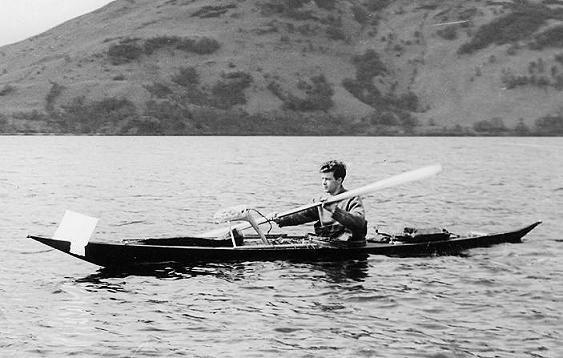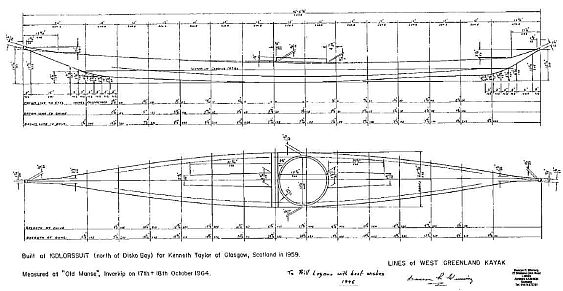Introduction
As I paddle an AnasAcuta (VCP - Valley Canoe Products) for years already, I think it´s just about time to write a review on her. :wink:
The interesting fact about the AnasAcuta, being introduced in 1972 already, is that she is still in production. Which is remarkable because that gives her a history of 36 years!
A kayak with such along history is interesting because we can learn from a kayak that appeals so long to paddlers.
The reason could be that there are enough paddlers who appreciate the beautiful and original Inuit-look of this kayak. But certainly it has also something to do with the capacities of the kayak. Often heard are positive comments on her playfulness and rough water handling: it is just fun, paddling an Anas Acuta. That’s what they say. And I can only agree with that.
As quite a lot of kayaks are based on this first fiberglas seakayak, you could say that she has a quite a pedigree.
But lets start at the beginning:
The origins of the AnasAcuta.
It seems very clear that the AnasAcuta is modelled after an original native Inuit kayak. It is also said she is the first fiberglass sea kayak.
To go back to the roots of the AnasAcuta I did an extended survey on the WWW.
However, as it is long ago when she was developed, the origins are a bit shaded, although all discussions about the AnasAcuta are pointing back to Greenland.
But thanks to paddlers, discussing the AnasAcuta on the QAJAQ USA forum, I was able to reconstruct the most likely history:
- Some seventy or so years ago a Scot, Harald Drever visited the island of Ubekendt in Umanak Fjord in West Greenland, over 500 kilometres north of the Arctic Circle. He was there to study the geology and found that the best way to access the coastline was by kayak. He formed a great affinity with the islanders and returned many times over the years, accompanied by fellow geologists from St Andrews University, where he became a professor. He was so highly thought of by the Greenlanders that they have named their modern school in Igdlorssuit, the only village on the island, “Harald’s School” in his honour.
In the late 1950’s, Ken Taylor, a young anthropology student at The University of Glasgow, a member of the Scottish Hostellers Canoe Club, was on a kayak trip on the north west cost of Scotland when he met Drever, who was on holiday there with his family. Drever persuaded Ken to go to Igdlorssuit to study the Kayak and its place in Inuit culture. So in the summer of 1959 Ken, helped by introductions from Harald, spent three months with the islanders on (South )Western Greenland, in the course of which he had a sealskin kayak made for him by the 50 year old local builder, one Emanuele Korniliussen. It is reasonable to assume that this specially made kayak was enlarged for Ken’s comfort. - So after his private one-man expedition to (South )Western Greenland in the summer of 1959, Ken Taylor brought a kayak back to Scotland.
This particular kayak excited special interest because it was a more moderate example of the West Greenland type.

- After Kenneth moved to the USA in 1964, to continue his anthropological career, Joe Reid and Mr. Duncan Winning, O.B.E. of Scotland, carefully surveyed the skin kayak and Duncan produced a longitudinal profile and cross sections. He probably distributed copies of his drawings quite freely throughout the U.K.

- These line drawings probably led to the development of several canvas covered and plywood replicas.
Duncan also passed the drawings onto Geoff Blackford, one time head of Canoeing at the Calshot Activities Centre in the south of England. Geoff increased the boats length by about 10 inches, enlarged the cockpit and raised the foredeck to accommodate European sized paddlers. He also altered it’s ends to produce a plywood boat. The result, which he called the Anas Acuta, proved to be very successful. - Blackford's craft was used as the plug for a fiberglass mould and eventually found its way to Frank Goodman of Valley Canoe Products
- In 1972 Frank Goodman began commercially producing this boat design in fiberglass under the name 'Anas Acuta'. Doing so he introduced the company to the world of sea kayaking while producing the first fiberglass seakayak.
By the way: It seems that the original Anas, the plywood and glass prototype, nowadays hangs over a bar in Northern Wales. Pub-stories?? - Several years after this, an English mountain climber and hang glider, Colin Mortlock, proposed an expedition, using kayaks, along the Arctic fjords of Norway to Nordkapp, the northern-most cape of Europe..
- Practising for the expedition, Mortlock and his team paddled the AnasAcuta kayaks around the Isle of Skye. After experiencing difficulties in performing a rescue at sea while practising, they came to the conclusion that some further modifications were necessary and they developed bulkheads, hatches and internal bilge pumps. They also realised that they needed a faster, more capacious kayak than the AnasAcuta for the trip. A kayak that could take huge quantities of supplies without losing too much manoeuvrability and seaworthiness.
- They asked Frank Goodman of Valley Canoe Products to build it for them. The hull was redesigned and in 1975 Frank Goodman came up with a kayak design, having a basis in the West Greenland kayaks, but incorporating elements of standard boat design with a round bilge, capable of the extra load required: the 'Nordkapp' was born. Also still in production. She turned out to be one of the best kayak designs for long expeditions and has been famous since.
- The years following, the AnasAcuta stayed very much alive and, until now, paddlers has used the AnasAcuta for numerous expeditions and adventures. I don’t know all of them but a few I can mention:
- David Mann paddled the Anas Acuta for several thousand miles from northern Russia into the Mediterranean
- Circumnavigation of the UK
- …… - Although the AnasAcuta still exists today, it must be said that, not very long ago, VCP changed the model a bit:
At first the body of the AnasAcuta had hollow bottom panels; just like a canvas hull which will form itself by the upward pressure when floating on the water.
The latest mould however is changed on this and gives the Anas Acuta straight, flat bottom panels. It is less like an original Inuit-kayak, but it might be an improvement on paddling characteristics like speed.
Another change is the application of bigger oval hatches. What’s not changed is the cockpitsize: still, to my delight, the small ocean cockpit is used. - Most important sources:
- QAJAQ USA disc forum (discussions between Vernon Doucette, Greg Stamer, Harvey Golden)
- Garnock Canoe Club Scotland / Duncan R Winning, 14th February 2007
To be continued: more will follow on the AnasAcuta.
